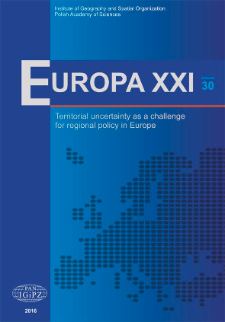- Wyszukaj w całym Repozytorium
- Piśmiennictwo i mapy
- Archeologia
- Baza Młynów
- Nauki przyrodnicze
Wyszukiwanie zaawansowane
Wyszukiwanie zaawansowane
Wyszukiwanie zaawansowane
Wyszukiwanie zaawansowane
Wyszukiwanie zaawansowane

Obiekt
Tytuł: Cohesion of the European regional space
Inny tytuł:
Wydawca:
Miejsce wydania:
Opis:
Każdy numer posiada własny tytuł.
Typ obiektu:
Abstrakt:
The purpose of the EU cohesion policy is to reduce disparities at the level of economic, social and spatial development of the underdeveloped regions. The Europe 2020 Strategy establishesmore growth- and innovation-oriented investments. The main objective of this paper is to analyze and evaluate the differences and dynamics of the EU regions at the NUTS 2 level, characterized by the selected variables in the economic, social and territorial accessibility (transport infrastructure) area to determine the clusters of different levels of disparities in the EU regions (HDI) and transport infrastructure as well as to examine their interdependence. Calculations were based on statistical data acquired from Eurostat databases. The results confirm a distinctively clear inequality of economic development in the European regional space between Central and Eastern Europe as well as Northern and Western Europe regions, with the highest growth of dynamics identified in the regions of the countries that joined the EU in 2007 and 2004. The analysis also identifies the European regions with a high level of spatial cohesion (accessibility) and validates the thesis about the presence of interdependence between the EU regional development and spatial cohesion (accessibility) of the regions.
Bibliografia:
1. Agenda Terytorialna Unii Europejskiej 2020, 2011. www.vati.hu/territorialagenda /TA2020_PL.doc [1 October 2015].
2. Gorzelak G., 2007. Polityka spójności Unii Europejskiej: od entuzjazmu do wątpliwości.Opolskie Roczniki Ekonomiczne, vol. 17, Opole: Polskie Towarzystwo Ekonomiczne.
3. Gorzelak G., 2009. Uwagi nt. dokumentu UE Green Paper on Territorial Cohesion Turning teritorial diversity into strength [in:] A. Baucz, M. Łotocka, P. Żuber (eds.) Spójność terytorialna wyzwaniem polityki rozwoju Unii Europejskiej. Polski wkład w debatę, Warszawa: Ministerstwo Rozwoju Regionalnego.
4. Grosse T.G., 2008. Czy polityka spójności może być bardziej innowacyjna? Samorząd Terytorialny, vol 6.
5. INTERCO, 2011. Indicators of territorial cohesion.
6. ESPON, https://www.espon.eu /export/sites/default/Documents/Projects/ScientificPlatform/Interco/INTERCO_DFR_Main-Report.pdf [1 October 2015].
7. European Commision, 2014. Inwestycje na rzecz wzrostu gospodarczego i zatrudnienia. Szósty raport na temat spójności gospodarczej, społecznej i terytorialnej. http://ec.europa.eu/regional_policy/sources/docoffic/official/reports/cohesion6/6cr_pl.pdf, [1 October 2015].
8. Proniewski M., 2012. Rozwój regionów peryferyjnych w Unii Europejskiej. Białystok: Uniwersytet w Białymstoku.
9. Strahl D., 2003. Spójność ekonomiczna regionu Dolnego Śląska, Vedecka Pojednani – Wissenschaftliche Abhandlungen, Prace Naukowe, Liberec, vol. IX.
10. Szlachta J.,2011. Polityka Spójności Unii Europejskiej po kryzysie [in:] Z. Strzelecki (ed.) Gospodarka regionalna Polski wobec globalnego kryzysu gospodarczego, Warszawa: SGH.
11. Szlachta J., 2011. Spójność terytorialna traktatowym wymiarem polityki strukturalnej Unii Europejskiej. Prace i materiały instytutu rozwoju gospodarczego, Warszawa.
12. Szlachta J., 2012. Strategia Europa 2020 a europejska polityka spójności po 2013. http://kolegia.sgh.waw.pl/pl/KAE/struktura/IRG/publikacje/Documents/pim88_9.pdf [1 October 2015].
13. TERCO, 2012. European Territorial Co-operation as a Factor of Growth, Jobs and Quality of Life, Main Report. ESPON, http://www.esponterco.eu/media/raporty/terco_ final_report_main_report.pdf [1 October 2015].
14. Zaucha J., Komornicki T., 2010. Spójność terytorialna, jako proces integrowania polityki rozwoju wobec terytorium, Sopot: Instytut rozwoju http://www.instytut-rozwoju.org/WP/IR_WP2014_03.pdf [1 October 2015].
15. Zielona księga w sprawie spójności terytorialnej, 2008. Bruksela http://ec.europa.eu/regional_policy/archive/consultation/terco/paper_terco_pl.pdf [1 October 2015].
Czasopismo/Seria/cykl:
Tom:
Strona pocz.:
Strona końc.:
Szczegółowy typ zasobu:
Format:
Rozmiar pliku 4,1 MB ; application/pdf
Identyfikator zasobu:
oai:rcin.org.pl:61352 ; 1429-7132 ; 10.7163/Eu21.2016.30.2
Źródło:
CBGiOŚ. IGiPZ PAN, sygn.: Cz.6406, Cz.6407 ; kliknij tutaj, żeby przejść
Język:
Prawa:
Prawa zastrzeżone - dostęp nieograniczony
Zasady wykorzystania:
Digitalizacja:
Instytut Geografii i Przestrzennego Zagospodarowania Polskiej Akademii Nauk
Lokalizacja oryginału:
Dofinansowane ze środków:
Unia Europejska. Europejski Fundusz Rozwoju Regionalnego ; Program Operacyjny Innowacyjna Gospodarka, lata 2010-2014, Priorytet 2. Infrastruktura strefy B + R
Dostęp:
Kolekcje, do których przypisany jest obiekt:
- Repozytorium Cyfrowe Instytutów Naukowych > Kolekcje Partnerów > Instytut Geografii i Przestrzennego Zagospodarowania PAN > Publikacje pracowników i Wydawnictw
- Repozytorium Cyfrowe Instytutów Naukowych > Kolekcje Partnerów > Instytut Geografii i Przestrzennego Zagospodarowania PAN > Biblioteka Instytutu > Serie/Czasopisma/Cykle
- Repozytorium Cyfrowe Instytutów Naukowych > Piśmiennictwo > Czasopisma/Artykuły
Data ostatniej modyfikacji:
13 paź 2023
Data dodania obiektu:
27 gru 2016
Liczba pobrań / odtworzeń:
725
Wszystkie dostępne wersje tego obiektu:
https://rcin.org.pl./publication/80453
Wyświetl opis w formacie RDF:
Wyświetl opis w formacie RDFa:
Wyświetl opis w formacie OAI-PMH:
| Nazwa wydania | Data |
|---|---|
| Proniewski M. - Cohesion of the European regional space | 13 paź 2023 |
Obiekty Podobne
Costa, Eduarda Marques da Palma, Pedro Rauhut, Daniel Humer, Alois Constantin, Daniela Velasco Echeverria, Xabier
Michniak, Daniel
Degórska, Bożena (1956– )
Komornicki, Tomasz
Epasto, Simona
Meier-Dallach, Hans-Peter Heinickel, Gunter

 INSTYTUT ARCHEOLOGII I ETNOLOGII POLSKIEJ AKADEMII NAUK
INSTYTUT ARCHEOLOGII I ETNOLOGII POLSKIEJ AKADEMII NAUK
 INSTYTUT BADAŃ LITERACKICH POLSKIEJ AKADEMII NAUK
INSTYTUT BADAŃ LITERACKICH POLSKIEJ AKADEMII NAUK
 INSTYTUT BADAWCZY LEŚNICTWA
INSTYTUT BADAWCZY LEŚNICTWA
 INSTYTUT BIOLOGII DOŚWIADCZALNEJ IM. MARCELEGO NENCKIEGO POLSKIEJ AKADEMII NAUK
INSTYTUT BIOLOGII DOŚWIADCZALNEJ IM. MARCELEGO NENCKIEGO POLSKIEJ AKADEMII NAUK
 INSTYTUT BIOLOGII SSAKÓW POLSKIEJ AKADEMII NAUK
INSTYTUT BIOLOGII SSAKÓW POLSKIEJ AKADEMII NAUK
 INSTYTUT CHEMII FIZYCZNEJ PAN
INSTYTUT CHEMII FIZYCZNEJ PAN
 INSTYTUT CHEMII ORGANICZNEJ PAN
INSTYTUT CHEMII ORGANICZNEJ PAN
 INSTYTUT FILOZOFII I SOCJOLOGII PAN
INSTYTUT FILOZOFII I SOCJOLOGII PAN
 INSTYTUT GEOGRAFII I PRZESTRZENNEGO ZAGOSPODAROWANIA PAN
INSTYTUT GEOGRAFII I PRZESTRZENNEGO ZAGOSPODAROWANIA PAN
 INSTYTUT HISTORII im. TADEUSZA MANTEUFFLA POLSKIEJ AKADEMII NAUK
INSTYTUT HISTORII im. TADEUSZA MANTEUFFLA POLSKIEJ AKADEMII NAUK
 INSTYTUT JĘZYKA POLSKIEGO POLSKIEJ AKADEMII NAUK
INSTYTUT JĘZYKA POLSKIEGO POLSKIEJ AKADEMII NAUK
 INSTYTUT MATEMATYCZNY PAN
INSTYTUT MATEMATYCZNY PAN
 INSTYTUT MEDYCYNY DOŚWIADCZALNEJ I KLINICZNEJ IM.MIROSŁAWA MOSSAKOWSKIEGO POLSKIEJ AKADEMII NAUK
INSTYTUT MEDYCYNY DOŚWIADCZALNEJ I KLINICZNEJ IM.MIROSŁAWA MOSSAKOWSKIEGO POLSKIEJ AKADEMII NAUK
 INSTYTUT PODSTAWOWYCH PROBLEMÓW TECHNIKI PAN
INSTYTUT PODSTAWOWYCH PROBLEMÓW TECHNIKI PAN
 INSTYTUT SLAWISTYKI PAN
INSTYTUT SLAWISTYKI PAN
 SIEĆ BADAWCZA ŁUKASIEWICZ - INSTYTUT TECHNOLOGII MATERIAŁÓW ELEKTRONICZNYCH
SIEĆ BADAWCZA ŁUKASIEWICZ - INSTYTUT TECHNOLOGII MATERIAŁÓW ELEKTRONICZNYCH
 MUZEUM I INSTYTUT ZOOLOGII POLSKIEJ AKADEMII NAUK
MUZEUM I INSTYTUT ZOOLOGII POLSKIEJ AKADEMII NAUK
 INSTYTUT BADAŃ SYSTEMOWYCH PAN
INSTYTUT BADAŃ SYSTEMOWYCH PAN
 INSTYTUT BOTANIKI IM. WŁADYSŁAWA SZAFERA POLSKIEJ AKADEMII NAUK
INSTYTUT BOTANIKI IM. WŁADYSŁAWA SZAFERA POLSKIEJ AKADEMII NAUK




































